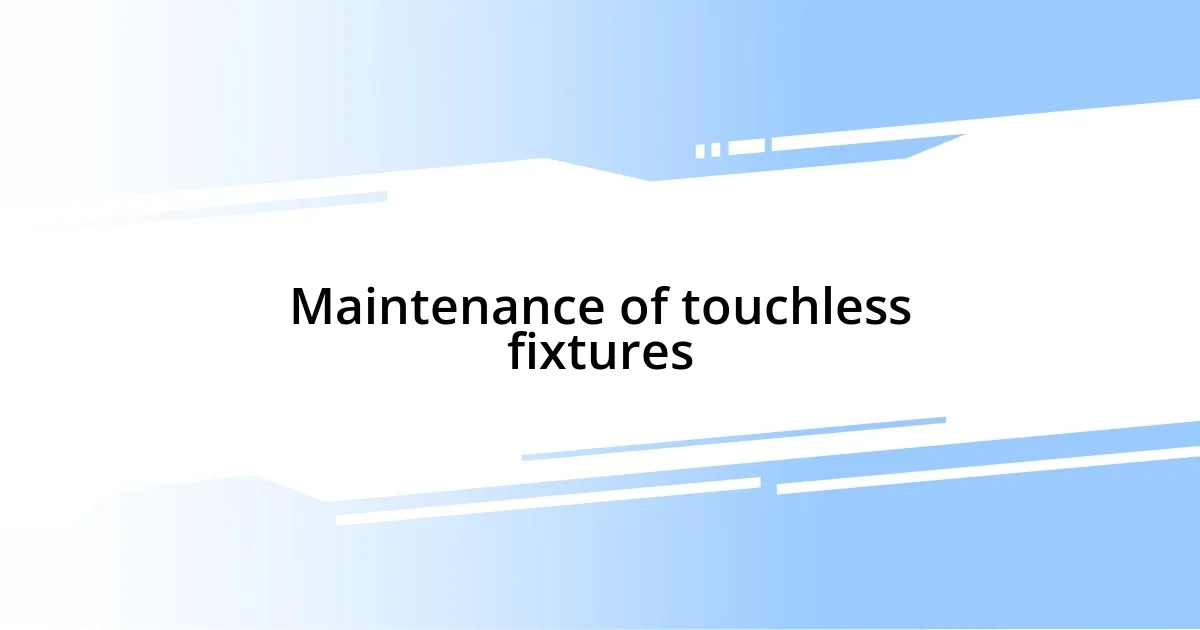Key takeaways:
- Touchless fixtures enhance hygiene by minimizing contact with surfaces, reducing germ spread.
- They offer convenience and resource conservation, making daily tasks easier and more efficient.
- Installation is generally straightforward, but regular maintenance, like checking sensors and replacing batteries, is essential.
- Future trends include smarter integrations and a focus on sustainability in touchless technology.

Overview of touchless fixtures
Touchless fixtures are becoming increasingly popular in both commercial and residential settings, primarily due to their hygiene benefits. I remember the first time I used a touchless faucet. It felt like stepping into the future—not having to turn knobs with dirty hands was such a relief! This simple technology, using sensors to activate water flow, is a practical solution for reducing the spread of germs.
Beyond sanitation, these fixtures offer a level of convenience that truly enhances our daily routines. Have you ever found yourself wrestling with a soap dispenser when your hands are full? Touchless soap dispensers eliminate that frustration altogether. I’ve noticed how they add a touch of modernity to any space while also being user-friendly for all ages.
While the initial investment might seem higher than traditional fixtures, the long-term benefits can outweigh these costs. For instance, I’ve found myself saving water because the automatic shut-off feature keeps it flowing only as needed. Isn’t it fascinating how technology can lead to both efficiency and sustainability?

Benefits of touchless fixtures
Touchless fixtures offer significant hygiene advantages, which cannot be overstated. When I transitioned to a touchless faucet in my kitchen, I was pleasantly surprised by how much cleaner everything felt. No more dirty handprints on the handles! It’s little joys like this that genuinely make a difference in maintaining a sanitised environment, especially during cold and flu season.
Convenience is another compelling benefit of touchless fixtures. I remember hosting a family gathering, and the ease of using my touchless soap dispenser was a hit with everyone. Guests didn’t have to struggle with pumps; they simply waved their hands, and voilà—instant soap! This feature not only simplifies tasks but also encourages good hygiene habits among friends and family.
Perhaps one of the most surprising perks of touchless fixtures is their ability to conserve resources. I’ve become more mindful of my water usage since installing a touchless faucet. The sensors only release water when needed, effectively cutting down waste. It’s incredible to realise that a simple upgrade can contribute to better environmental practices while enhancing our everyday lives.
| Advantage | Description |
|---|---|
| Hygiene | Minimises contact with surfaces to help reduce germ spread |
| Convenience | Offers hands-free operation for easier use |
| Resource Conservation | Reduces water waste with automatic shut-off features |

Types of touchless fixtures
When I think about the types of touchless fixtures, several key options come to mind. Each type serves a unique purpose, and they’ve all found a way to effortlessly improve our lives. I remember being stunned by how many variations are out there, especially when I was upgrading my bathroom.
Here are some common types of touchless fixtures:
- Touchless Faucets: These use sensors to detect hands underneath, dispensing water without the need for handles. I was amazed at how quickly my kids learned to use it!
- Touchless Soap Dispensers: With an infrared sensor, these dispensers provide soap on demand. It was a game-changer during flu season; my family’s handwashing game was on point!
- Touchless Toilets: These models can flush automatically—so handy! I’ve had moments where I didn’t have to touch anything after use, which felt quite luxurious.
- Touchless Paper Towel Dispensers: These offer a quick, mess-free way to dry hands. I recall my surprise the first time it dispensed perfectly without any contact, making my kitchen feel even more hygienic.
Each of these types caters to different areas of our daily lives, enhancing convenience and cleanliness in ways I didn’t even know I needed. They neatly blend technology and practicality, making me appreciate even the simplest daily tasks.

Installation of touchless fixtures
When I decided to install touchless fixtures in my home, I wasn’t quite sure what to expect. However, the installation process turned out to be surprisingly straightforward—just follow the instructions and connect a few hoses. I remember feeling a mix of excitement and anxiety as I tightened the last screw, hoping it would all work seamlessly.
One aspect that took me a bit off guard was the amount of space required for some of the sensors. While I was measuring for my touchless faucet, I wondered, “Would I actually have enough under-sink room for this?” Thankfully, after some careful planning, everything fit perfectly, and I felt a rush of satisfaction seeing it all come together.
After installation, I noticed how many of my friends and family were curious about my new fixtures. They often asked, “How difficult was it to set up?” I shared how I had managed it all by myself, which sparked conversations about their own home upgrades. It felt rewarding to inspire others to make small but significant changes in their own spaces!

Maintenance of touchless fixtures
Maintaining touchless fixtures is generally simple, but it’s crucial to stay on top of a few key tasks. For instance, I make it a point to regularly check the sensors for any dirt or grime that could interfere with their operation. The first time I noticed the soap dispenser wasn’t sensing my hand properly, I had a mini-panic until I realized a quick wipe was all it needed!
I’ve also learned that changing batteries is a necessary part of upkeep. When my touchless faucet abruptly halted in the middle of dinner prep, I couldn’t help but feel frustrated. It was a simple fix though—I just needed to remember to keep spare batteries handy. This small practice saves me from unexpected hiccups, especially during busy moments.
Another maintenance tip I’ve found useful is to monitor water pressure. Too high a pressure can wear out the internal mechanisms faster than expected. I once had a faucet blasting water, and adjusting the pressure made a world of difference, both in performance and in my kitchen’s tranquility. Wouldn’t it be great if everyone knew just how important these little checks could be?

Comparison with traditional fixtures
Comparing touchless fixtures to traditional options reveals some fascinating differences. I remember the first time I used a traditional faucet after installing my touchless one—it was almost jarring to physically twist and pull a handle. The convenience of simply waving my hand feels like a little luxury I didn’t know I needed until I experienced it.
In terms of hygiene, touchless fixtures stand out significantly. I often think about how many germs and grime are transferred simply by touching handles. With my touchless faucet, I can easily avoid that, making it an appealing option, especially when hosting friends and family. Remember that time you washed your hands after touching something dirty? I find the ability to stay hands-free reassuring.
However, there’s something to be said for the instant familiarity of traditional fixtures. I’ve noticed that when I have guests over, some feel a bit hesitant using the touchless features. They often ask, “How do I turn it on?” Which makes me wonder: is there a learning curve that might deter some people from fully embracing this modern technology? Ultimately, while both options have their merits, adapting to the conveniences of touchless fixtures seems to win the day for efficiency and cleanliness in my experience.

Future trends in touchless technology
I think the future of touchless technology holds exciting possibilities. For instance, as I observe the rapid advancements in sensor technology, I can’t help but feel a sense of awe. Imagine fixtures that can not only detect motion but also learn your preferences over time—like automatically adjusting the water temperature based on your last settings. Doesn’t that sound like a glimpse into the future?
I’m also intrigued by the integration of smart home systems with touchless devices. Recently, I installed a smart hub that connects all my home appliances, and I find it mind-blowing how easily everything can work together now. Picture this: you could walk into your bathroom, and the touchless faucet not only turns on but also syncs with your smart mirror to display the weather, all while maintaining perfect water flow. What about that? It feels like living in a sci-fi movie!
There’s also a growing focus on sustainability in touchless technology. I remember feeling proud when I learned that some new models are designed to conserve water while maintaining optimal performance. This means we can enjoy the convenience of touchless options without the guilt of wasting resources. Isn’t that a win-win for all of us? As these trends unfold, it’s clear that the future looks not only more convenient but also more responsible.














